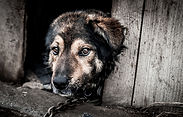
Key terms
Law has been described as ‘a house of words’ because the discipline of law is completely dependent on language.[1]
Words and phrases within law establish legally enforceable responsibilities upon those within the jurisdiction to which the legal rules apply.
The responsibilities (i.e. ‘duties of care’) mandate what people must do, and must not do, in terms of behaviours. In turn, people’s individual and collective behaviours result in personal, community and global consequences. Ensuring legal responsibilities accord with societal needs and targeted outcomes are among the unique purposes of ‘law’.
This section provides a quick reference guide to fundamental terms used within animal welfare law:


A duty of care is a legal obligation which is imposed on an individual requiring adherence to a standard of reasonable care while performing any acts that could foreseeably cause harm to another individual, including, for example, their rights, their liberties or their property (e.g. animals).
Typically, animal laws apply a broad net of responsibility to people regarding interactions that affect the wellbeing of animals. Those responsibilities include, but are not limited to, owners or persons in charge of animals. The duty of care requires compliance with legally prescribed standards associates with acts or omissions that impact an animal's welfare.

Contemporary science validates that, in addition to experiencing negative [physical, mental, emotional] states (i.e. pain, distress, suffering), animals also experience positive states (e.g. comfort, interest, pleasure).
The Five Domains model refers to four physical/functional domains of "nutrition", "environment", "physical health" and "behaviour", and the fifth domain is the animal's "mental" state.
"Extending the 'Five Domains' model for animal welfare assessment to incorporate positive states", Mellor and NJ Beausoleil, Animal Welfare 2015, 24: 241-253SSN 0962-7286doi: 10.7120/09627286.24.3.241

Now over half a century old, the "scientific knowledge" and principles of the Five Freedoms contained within the Brambell Report (1965) outline five aspects of animal welfare under human control.
They advocate that an animal should be provided for in such a way that it experiences freedom from hunger and thirst, freedom from discomfort, freedom from pain, injury or disease, freedom to express natural behaviour, and freedom from fear and distress.
For the purposes of distinguishing the Five Freedoms from the Five Domains, it is helpful to note that the Five Freedoms all reference freedom from negative states.

Negative states commonly referred to in anti-cruelty law include pain, distress and suffering.
These states are the consistent focus of animal protection / anti-cruelty law.

The concept and terminology of “positive animal welfare” arose following the recognition in debates and assessments that “animal welfare” focused too much on avoiding negatives.
The term "positive animal welfare" emphasises the welfare relevance of providing animals with opportunities to have positive experiences, in addition to minimising negative ones.
The phrase "less pain is not the same as more pleasure” often helps to identify the difference between anti-cruelty and positive animal welfare.
Positive animal welfare is terminology utilised and engaged by those involved in animal-related organisations (government, non-government organisations, industry, research, academia); however, it is put into practice by a comparative minority.
The Sentient Animal Law Foundation utilises the unique features of law toward ensuring that all people in charge of animals have a legal duty of care that is not restricted simply to protecting animals from cruelty, but also requires providing animals in their care with opportunities to experience positive states such as comfort, interest, pleasure.


Positive states include, for example, experiences of comfort, interest and pleasure.
Reference: "Extending the ‘Five Domains’ model for animal welfare assessment to incorporate positive welfare states Mellor* and NJ Beausoleil, Animal Welfare 2015, 24: 241-253ISSN 0962-7286doi: 10.7120/09627286.24.3.241

